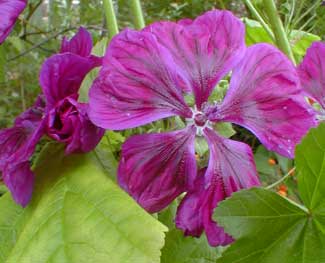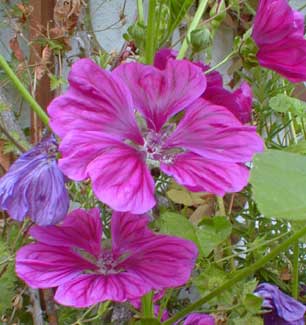
'Bibor Fehlo' High Mallow;
or, French Hollyhock
"All gardening is landscape painting."
-Alexander Pope
(1688-1744)
(1688-1744)
Malva sylvestris var. mauritiana High Mallow is native to Iberia, Italy & Algeria. It has in the past been regarded as its own species M. mauritiana but is presently regarded a variant of the more widely distributed M. sylvestris. The variant has larger flowers & larger leaves.
 High Mallow is also known as Blue Mallow, Tall Mallow, or Marsh Mallow. This & other Malva species have been called by the curious names Cheese (or Cheeses), Cheeseflower, or Cheese-weed, with numerous plays off the same idea, including Cheese-cake, Dutch Cheese, Doll-cheeses, Fairy-cheeses, Pick-cheese, or Cheese-log. This is due to the wheel-shaped carpels that remain after the flower petals fall, & which is supposed to resemble miniature cheese wheels, small enough for use by the fairies or at playtime with one's dolls. For this same feature it is sometimes called the Pancake Plant.
High Mallow is also known as Blue Mallow, Tall Mallow, or Marsh Mallow. This & other Malva species have been called by the curious names Cheese (or Cheeses), Cheeseflower, or Cheese-weed, with numerous plays off the same idea, including Cheese-cake, Dutch Cheese, Doll-cheeses, Fairy-cheeses, Pick-cheese, or Cheese-log. This is due to the wheel-shaped carpels that remain after the flower petals fall, & which is supposed to resemble miniature cheese wheels, small enough for use by the fairies or at playtime with one's dolls. For this same feature it is sometimes called the Pancake Plant.These cheesewheel fruits when still unripened are edible as a nut-flavored snack. When ripe they are too dry with the seeds hardened, but if harvested while still soft & green they can be eaten with sepals intact. The immature fruits have also been used for pickling, in salads, or in soups.
Dioscorides said mallows were by the ancient Romans called Hortensis, meaning "of the garden," indicating that mallows have been gardened for millenia. Their extremely wide range was probably fascilitated in past millenia by the spread of the Roman empire & the desire to bring the most easily transported seeds of familiar useful plants with them.
The names Malva & Mallow are corruptions of an ancient Greek name meaning "Soft," probably alluding to the soft leaves, though the plant has been so-named for millenia & the reason is not certain. It could have been called "Soft" for the sake of the mucilege content of the leaves & roots traditionally used as an emollient or gelatin, or for the mild tonic effects of teas brewed from fresh or dried leaves.
The cultivar 'Bibor Fehlo' begins flowering June or July, & continues flowering until autumn's first frost. Its name is Hungarian for "Purple Cloud." The wrinkled blossoms are an intense luminous royal purple with cloudy streaking of darker purple.
The first photo shows it in July when had reached more than five foot of height. When the flowers were spent I cut the stalks back by half & it began to rebloom almost immediately at three feet height. The second photo is from September.
Large with a relatively short life cycle, it looks like a tall narrow shrub but is a huge perennial or biennial. It's a very hardy as a bienniel or weak perennial, occasionally lasting more than the two years. Let it reseed itself, or collect the seed pods for more controlled rearing, in order to insure it is in the garden a great while.
Gardenable for zones five through eight, 'Bibor Fehlo' is quite frost-hardy. Its blooms are royal purple with deep gorgeous cloudy dark veining. This cultivar's blooms are larger than on the species, & the flower stocks stand six feet tall. It will probablyh need stakikng or can be grown against a fence or wall to which it might be tied.
It will settle for bright shade but really wants full sun to do its best. It will thrive in a wide range of conditions, other than dampness. It requires sharply draining soil, & has a preference for poor light soil with somewhat droughty conditions. It actually prefers loosened waste ground & roadsides in poor soil.
Their one drawback is how High Mallow leaves, like ordinary hollyhocks, are very susceptible to rust. They belong to the rear garden, with mid-sized perennials in front to hide the imperfect foliage. Young plants have much nicer foliage than mature, but it seems that eventually the leaves begin to look snarky even while the blossoms persist beautifully.
The leaves & flowers of High Mallow have been used as tonic teas in folk-medicine, fresh or dried, & the gelatinous mucilage derived from the leaves & roots has likewise been long regarded as possessing healing properties. Pliny the Elder believed that a spoonful of mallow gelatin taken every morning would protect the user from any illness for a full 24 hours. The Roman poet Horace thought its daily use increased intellect & moral virtues. The Greek mystic Pythagoras seemed to believe it functioned like saltpeter, boasting as he did that mallow reduced physical passions rendering mind & body cleaner.
Modern health food vendors & herbalists still make some pretty amazing claims for mallows, mostly without substantiation, though its use as a saltpeter substitute to keep men impotent & moral is not high on the advertised list of desirable attributes.
Amusingly, it turns out Pythagoras had one of the clearest understandings of mallow's value. Modern studies on dogs, mice & rats have concluded that the chemical embalin in mallows has an anti-androgenic effect lowering male fertility, reducing testical size & sperm count. But, well, "ancient wisdom" is only promoted by herbalists if it suits the whims of their vending patterns, & is unrelated to what has been proven or disproven. So don't expect one of the few genuine effects to be trumpeted down there at the New Age Headshop & Health Food Barn.
Nor is it necessarily safe if used too often, because mallows possess a carbohydrate that can interfer with the immune system. It has also proven mildly toxic as livestock silage, causing "the staggers" in horses, cattle, & sheep, though they usually recover; the specific toxin effecting livestock has never been identified. If it is fed to chickens it causes the egg yolks to turn pink, an effect of the plant's fatty acids.
High Mallow tea would be more safely used as a gargle for soar throat & cough, or topically for irritated skin or eczema or bee stings. Its efficacy, however, is debatable & no herbal product containing High Mallow has ever been proven to be honestly useful for anything. Nevertheless, some of its chemical components in the form of pharmaceutical grade extracts have been shown to possess antibacterial, anti-inflammatory, antifungal, & antioxidant properties in laboratory settings.
Young leaves can be used in salads, & the variant mauritiana has the tastiest leaves. The blooms, too, are flavorful, & can add splendid color to a salad. As a food item High Mallow is best when grown in poor light soil. If grown in organically rich soil, excesses of nitrates will be stored in the leaves, rendering them inedible; in M. parviflora the nitrate can reach actually toxic levels, & probably the same could happen with M. silvestris. Any potential problem is easily avoided by harvesting leaves only from mallows growing in poor soils.
Bare in mind over use whether as a food or a medicine may have a negative impact on the immune system, though there is no risk for occasional use. Leaves are even more safely eaten if well-cooked, useful in any hot spinach recipe. When added to soups, the high mucilage content of the leaves functions as a thickener.